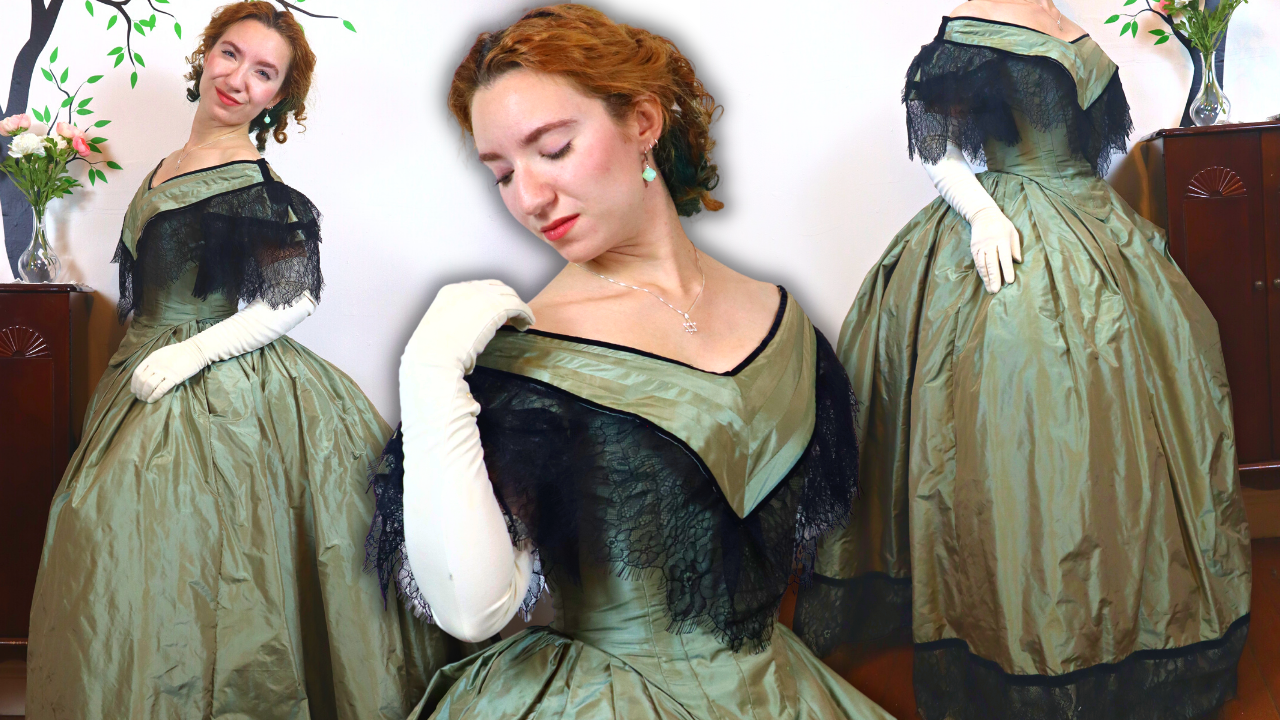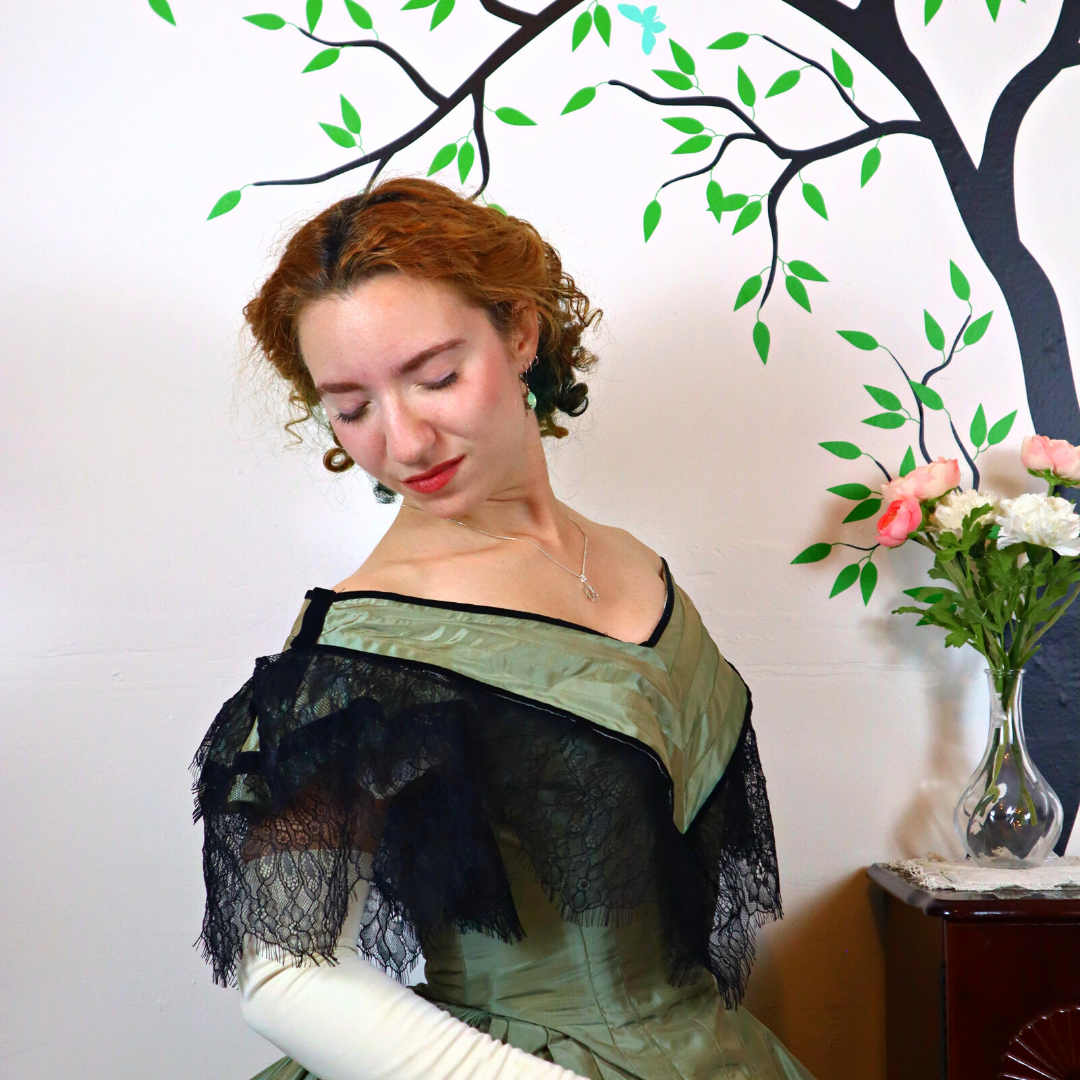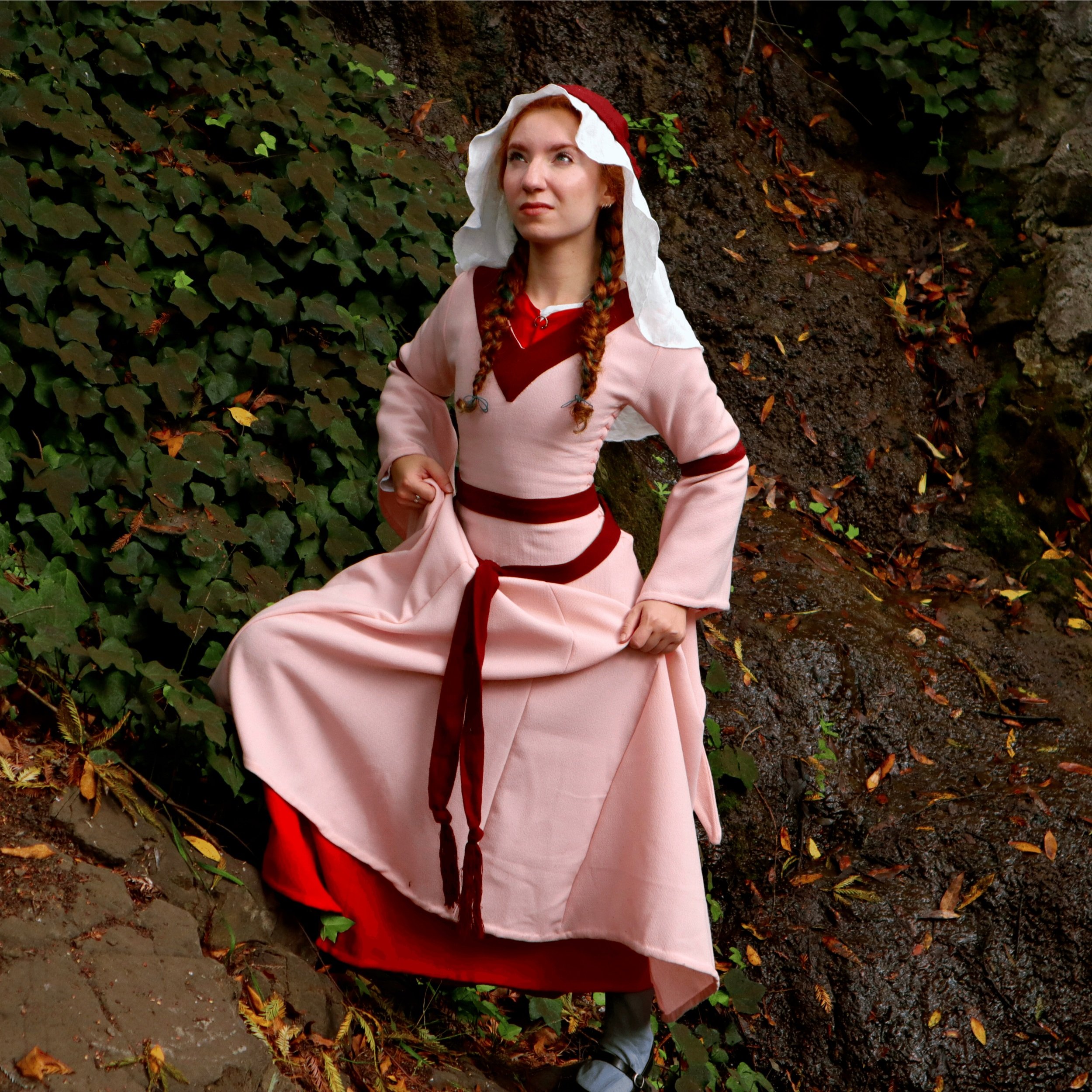Sewing a Victorian evening gown skirt from 1865
Sewing a Victorian evening gown skirt from 1865
I'm sewing a Victorian evening dress for Mirah Lapidoth from Daniel Deronda by George Eliot! We’ve already researched the setting and dress etiquette, made a lightweight and comfortable hoop skirt, and now it’s time to start on the easiest part of this ball gown : the skirt.
Why Daniel Deronda?
Daniel Deronda by George Eliot is a remarkable work of Victorian literature, and the BBC's Daniel Deronda 2002 adaptation is a classic source of inspiration for historical costumers interested in Victorian dress. This Victorian skirt is the first part of making a Victorian gown for one of the main characters : A Jewish opera singer named Mirah Lapidoth. What sets Daniel Deronda apart among popular works of historical literature is it’s full, multifaceted, and sympathetic portrayal of Jewish characters, including a Jewish romantic heroine who has her own version of a storybook happy ending. This Victorian novel’s portrayal of Jewish characters is shockingly accurate, given that George Eliot was not Jewish.
Sewing the ballgown
Making a Victorian ball gown is quite a process, so this video is focusing on how to sew a Victorian skirt circa 1865. Some aspects of Victorian clothing are deceptively simple, and this is definitely one of the easier parts of Victorian dress making. At this point in dress history, skirts could be made of rectangular panels gathered or pleated to the skirt waistband and with a placket at the closure. This Victorian skirt pattern is all rectangles, and might be a great beginner Victorian skirt DIY ! To complete this Victorian evening dress, I’ve sewn a ball gown bodice and a day bodice as well.
This doesn’t look anything like the TV miniseries!
While the 2002 BBC adaptation of Daniel Deronda is set in 1876, the era of the Victorian bustle gown, I chose to go with the book's original setting of 1864 to 1865 because I prefer mid-Victorian fashion. The finished Victorian evening gown will look very much like a Victorian era ball gown even though it is made with a house concert setting in mind. If you enjoyed reading or watching Daniel Deronda, I hope you'll enjoy this Victorian sewing project series! And if you haven't read or watched Daniel Deronda, I hope you'll give it a try.
-
This video is brought to you by Squarespace, whose all-in-one website creation platform is helping me build a pretty website to go with all the pretty dresses.
Also, this video contains major spoilers for Daniel Deronda. But I promise they’re worth it.
Her look was full of wondering timidity such as the forsaken one in the desert might have lifted to the angelic vision before she knew whether his message was in anger or in pity.
“You want to know if I am English?” she said at last, while Deronda was reddening nervously under a gaze which he felt more fully than he saw.
“I want to know nothing except what you like to tell me,” he said, still uneasy in the fear that her mind was wandering . . .
. . . “Yes, I will tell you. I am English-born. But I am a Jewess.”
My first encounter with George Eliot’s supposedly “most complicated” work came during one of my endless searches for new period dramas to watch, in the form of the 2002 BBC adaptation. We begin with Gwendolen Harleth; everything we expect in the heroine of Victorian novel, a beautiful and spirited English girl in reduced financial circumstances. And Daniel Deronda, the mysterious young gentleman whose presence in her life challenges her to become a better person.
. . . or so we thought.
While the adaptation is set in 1876, the year the novel was published, Eliot’s setting is 11 years prior in 1865. Skirts of the time were just starting to take on a gored or eliptical shape, but I think I can still get away with straight panels, using three simple widths of fabric from selvedge to selvedge, each as long as my intended skirt length plus hem allowance. I’ll use pleating and fabric distribution to create a subtly back-heavy silhouette, by knife-pleating one panel for the front and cartridge-pleating the other two into the back.
When you’ve spent your whole life having to choose between never seeing yourself represented in historical or historical-themed literature, and denying your identity so you can see yourself in the heroine, there is something immensely satisfying about how George Eliot sets up the plot of Daniel Deronda. Obviously the heroine is Gwendolen, right? We know how this story ends— with her improving her character through trials and tribulations, and winning the eligible leading man over. So when we meet Mirah Lapidoth, an even-more-mysterious woman singing her despair from a riverbank as Deronda rows by, it isn’t clear just why Eliot has introduced her to us. Mirah, at first, seems to exist only to be the quieter, less entitled foil to Gwendolen’s high origins and ideas of her own greatness. I braced for this story to go the way of Ivanhoe and sacrifice the long-suffering Jewess’s happy ending so we can focus on our real, more suitable heroine.
Perhaps George Eliot was bracing for it right with me, because she then sets up one of the most validating and impressive literary bait-and-switches I have ever seen.
Mirah is an opera singer, trained from a young age by her morally-bankrupt but theatrically-educated father and his circle of friends. As she grows up and discovers her voice is not suited for stage performance, she faces her limitations with, arguably, much better grace than Gwendolen faces her own ill-fated attempt at a singing career. Thanks to an introduction from Deronda, she is invited to sing an evening house concert at the home of his adoptive father . . . and this, her professional and personal coming-out in the world, is the occasion I aim to dress for.
With both the front and back panels of the skirt prepared, I can start on construction. There will be a hook-and-eye closure at the right side, so I’m adding a simple rectangular placket there. The back piece has the edges folded under and will extend an inch past the back right panel, encasing the edge. The front piece is sewn right sides together to the front panel, and is then turned over to the inside and felled in place by hand, serving more as a reinforcement than anything else.
While I’m handsewing, I can also start on the cartridge-pleating. This is cotton crochet thread, a sturdy material which actually came in a matching color to this gorgeous shot silk taffeta. Cartridge-pleating is done by using evenly-spaced running stitches to gather fabric into perfect tiny folds, which is why I made all those marks along the top edge. Yes, I am still hand-sewing from bed despite the fact that I’m an extremely serious proper professional dressmaker and this is my job now . . .
Aaaand given this is my job now, I should probably have a website or something. {aside} Feel free to picture Bianca of BookHoarding, CosTube’s resident social media pro, scolding me for not having one already . . . because that’s literally what happened.
Enter Squarespace, who have made web design easy enough that I think even my clueless self can make something that looks good. There are a huge number of templates to choose from, organized by field or purpose. Once I chose a template, it was really easy to customize it for my aesthetic. A friend who has actual design skills helped me make a palette out of the colors I’ve decorated my studio with. Then, I could just copy and paste into the Site Styles section to apply those colors to my website. Something about having a website that’s color coordinated to my sewing room is incredibly satisfying.
If you, like me, need a little push to get your site going, head over to squarespace.com/SnappyDragon and they’ll give you a 10% discount on your first website or domain purchase. I’m gonna keep you posted on the design process, so stay tuned to see how it’s coming together.
[soft piano music, rustly silk ASMR]
As the story of Daniel Deronda progresses, Mirah’s presence grows to encompass more and more of the plot. Even though she herself is unassuming, her influence touches almost every other character in the book. She is the spark, the catalyst, that sends Deronda— and in many ways Gwendolen too— on their journeys to better understand who they are and who they could be. And yet, Eliot manages to write this role for her without reducing her to a mere plot device in service of other characters. She is no less whole and human. She has her own dreams and goals, her own desires, her own fears and faults. And while it would be easy to dismiss her strength because she has such a modest demeanor, there is an unmistakeable determination in her. Against all odds, she escapes from a father who used and mistreated her, makes her home in a house with strangers and a city where she knows no one, and launches a career in the face of overwhelming prejudice. Eliot honestly astounded me with her ability to write the experience of Jewish characters, down to the tiny antisemitic microaggressions Mirah faces from the Meyricks, the friends of Deronda who she lives with. Many 21st century authors don’t come half so close to accurately speaking to how marginalized people move through the world, and I can only imagine what kind of research Eliot must have done.
The waistband of the skirt is a simple rectangle, left open to encase the knife-pleated front panel, but sewn into a tube and turned out so the cartridge-pleated back can be hand-sewn to the edge. Once the waistband is on, I can put the skirt on and decide if I want to adjust the length.
I have to make an amendment to a previous video here. The corded petticoat I made last month unfortunately kept buckling into uneven lumps, even with all the additional rigging, so I gave up and added a single hoop of 6 millimeter synthetic whalebone into the third row of twill tape. This solved the problem *completely*, so while I can no longer say this petticoat has no hoops, it continues to be far lighter and more flexible than a steel hoopskirt.
I had no idea what to expect when I first watched the BBC adaptation, other than some visually enjoyable background noise while I sewed. The introduction of any Jewish character at all was a massive surprise, let alone one who is portrayed with humanity and compassion rather than stereotyping and prejudice. If you’re not of the narrow demographic that takes the lead in most historical literature or media, you probably know the feeling of wanting to identify with the characters, to fully experience the story, but having to forget and disregard and cut away parts of yourself to do so. A lot of times, it simply isn’t possible, and all you can feel as you watch or read is a lingering sense of exclusion, of otherness. The story becomes yet another voice in the chorus telling you that you don’t belong here. You don’t deserve to end up happy. Your role is villainy, or service, or to be left out altogether. There is no room at all in this world for you.
George Eliot’s technique in changing the narrative is masterful. She draws in the non-Jewish reader through the character of Gwendolen. She creates a scene and a premise that they are comfortable in . . . and then slowly, surreptitiously, shifts that premise so the reader must identify with Jewish characters, must empathize with their struggles and cheer for their successes— or put the book down and leave the tale unfinished. To watch the story turn away from a prejudiced society’s expectations, just as Deronda turns towards his Jewish friends and his Jewish identity, is a powerful affirmation to Jews and non-Jews alike that we do belong here. We do have a place in these stories, and we do deserve happiness.
[music ends and fades, thread hisses]
Daniel Deronda was revolutionary in the 19th century, as a novel that focused on marginalized characters in a positive light. But there are still so many stories that are missing, from 19th century literature and the historical media of today. We are only beginning to see BIPOC characters, disabled characters, queer and trans and nonbinary characters, and so many others, featured in historical media with empathy and humanity and focus. We are only beginning to see stories that showcase their happiness, and reinforce that they deserve joy and love as much as a “traditional” historical heroine.
Those of us who can see ourselves more often and more easily in historical media can make this possible for others. We can call for more diverse casts and characters, for truer and more compassionate representation, and for stories from all over the world to be told. We can be loud and purposeful in our enjoyment of media that gets it right. I hope every one of you is able to have this experience : to see yourself truly represented in the stories you love. I hope that chorus of voices tells you that you do belong here, you do deserve happiness, and you should not have to shut away parts of yourself to be welcome. And if you like silk evening gowns, you deserve to wear them without any further justification than your own joy.





